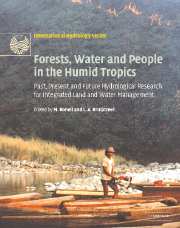 Forests, Water and People in the Humid Tropics
Forests, Water and People in the Humid Tropics Book contents
- Frontmatter
- Contents
- List of contributors
- Foreword
- Preface
- Acknowledgements
- Symposium and Workshop
- Introduction
- Part I Current trends and perspectives on people–land use–water issues
- Part II Hydrological processes in undisturbed forests
- Part III Forest disturbance, conversion and recovery
- Part IV New methods for evaluating effects of land-use change
- Part V Critical appraisals of best management practices
- 35 Guidelines for controlling vegetation, soil and water impacts of timber harvesting in the humid tropics
- 36 Minimising the hydrological impact of forest harvesting in Malaysia's rainforests
- 37 Red flags of warning in land clearing
- 38 From nature to nurture: soil and water management for rainfed steeplands in the humid tropics
- Conclusion: Forests, water and people in the humid tropics: an emerging view
- Plate section
- References
38 - From nature to nurture: soil and water management for rainfed steeplands in the humid tropics
from Part V - Critical appraisals of best management practices
Published online by Cambridge University Press: 12 January 2010
- Frontmatter
- Contents
- List of contributors
- Foreword
- Preface
- Acknowledgements
- Symposium and Workshop
- Introduction
- Part I Current trends and perspectives on people–land use–water issues
- Part II Hydrological processes in undisturbed forests
- Part III Forest disturbance, conversion and recovery
- Part IV New methods for evaluating effects of land-use change
- Part V Critical appraisals of best management practices
- 35 Guidelines for controlling vegetation, soil and water impacts of timber harvesting in the humid tropics
- 36 Minimising the hydrological impact of forest harvesting in Malaysia's rainforests
- 37 Red flags of warning in land clearing
- 38 From nature to nurture: soil and water management for rainfed steeplands in the humid tropics
- Conclusion: Forests, water and people in the humid tropics: an emerging view
- Plate section
- References
Summary
INTRODUCTION
Rainfed farming continues to expand in the humid tropics as the population grows, and natural forests are being replaced by agriculture on increasingly steep hillsides. This process may be abrupt but more often occurs through a series of gradual changes in land use: from forest modification, to shifting agriculture, through settlement mosaics and on to eventual complete forest replacement (Sayer et al., 2000). Often, the gradients in question are above theoretical legal limits for cultivation (Moldenhauer and Hudson, 1988) (Figure 38.1). The challenge is to identify and offer practical solutions for soil and water conservation in these areas that are both technically appropriate and socially acceptable. It is increasingly realised that measures must address water, fertility and production aspects simultaneously, as well as the prevention of surface erosion. These systems should be sound in technical terms so that they control damage to the soil and to the hydrological integrity of the hillsides. They should also sustain plant production. Social acceptability is the acid test of adoption: if ‘solutions’ are not attractive to land users they will not be sustained and they will not spread.
Since world-wide concern with soil erosion (‘the problem’) and soil conservation (‘the solution’) spread in the 1930s and 1940s, catalysed by the great dust bowl phenomenon in the United States (Anderson, 1984), there have been significant shifts in conceptual thinking. In summary, it has been recognised that top-down schemes based on engineering techniques have largely failed to deliver.
- Type
- Chapter
- Information
- Forests, Water and People in the Humid TropicsPast, Present and Future Hydrological Research for Integrated Land and Water Management, pp. 881 - 905Publisher: Cambridge University PressPrint publication year: 2005


